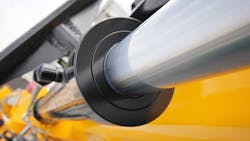Sizing Accumulators for Arbitrary Moves
A challenging issue for fluid power engineers is to calculate the proper accumulator size. A recent article by Peter Nachtwey, president of Delta Computer Systems, takes an in-depth look at the calculations and strategies.
“To calculate the right size for the accumulator, the engineer must know how much the volume of oil or gas changes during operation,” Nachtwey writes in the article. “Oil is simultaneously being removed by flow through servo valves and added by a pump. If the pump could instantly supply the amount of oil being used, there would be no need for the accumulator.
There also are variables to consider. “To size an accumulator for a hydraulic servo system, it makes sense instead to use a motion controller to help calculate the accumulator size,” Nachtwey writes. “Finally, whatever method is used to compute the accumulator, chances are that exact accumulator size is not available, so the next size bigger must be used.”
Energy Value for Pneumatics
In a wide-ranging interview with Hydraulic & Pneumatics Senior Editor Rehana Begg, Rich McDonnell, product manager, Smart and IoT Digital Products, Parker Hannifin, said there will be changes in the way pneumatic systems operate in response to a continuing emphasis on energy management and a greater availability of sensors in pneumatic systems.
“Flow control and proportional control is going to be a key element of energy conservation. Traditionally in pneumatics you would save energy—even before it was a buzzword—by dual pressure regulation in a circuit,” McDonnell said. “Dual pressure regulation was a regulator on a particular station of a manifold. So, you would have on your work function (inside of your actuator) higher pressure and then you’d retract that with a lower pressure. That saves energy because you’re using less energy that return.
“We’ll see a shift to more proportional flow control in functionality in the future. And because of that, those two technologies are going to become much more important, because now you can control that very discreetly and accurately via the embedded control,” he added. “Then, when machines are idle or you want them to sleep for a period of time, you’ll be able to bring that net pressure down to just very minimal operating set up parameters to save energy.”
About the Author
Bob Vavra
Senior Content Director, Power & Motion and Machine Design
Bob Vavra is the Senior Content Director of Power & Motion and its sister publication Machine Design. Vavra has had a long career in publishing, media and events. He has covered all aspects of manufacturing for the past 20 years and is a regular attendee at events such as IMTS and Hannover Messe. Vavra is also a sought-after webcast moderator and event emcee, and has presided over events in the U.S., Germany and China.

Leaders relevant to this article:
